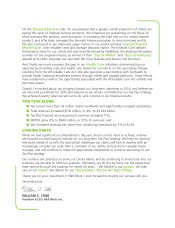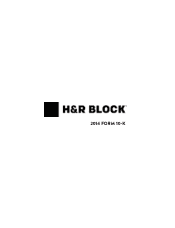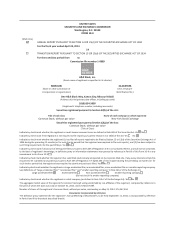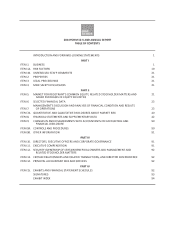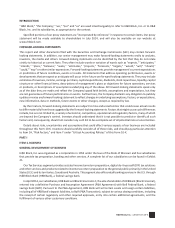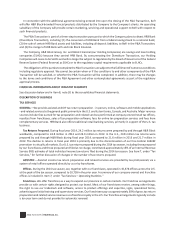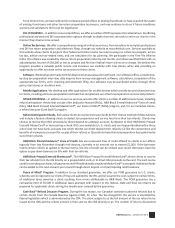HR Block 2014 Annual Report Download - page 14
Download and view the complete annual report
Please find page 14 of the 2014 HR Block annual report below. You can navigate through the pages in the report by either clicking on the pages listed below, or by using the keyword search tool below to find specific information within the annual report.
62014 Form 10-K | H&R Block, Inc.
the Federal Reserve has issued a regulation that SLHCs, and their nonbank subsidiaries, may only engage in such
financial activities if the SLHCs qualify for and elect to become FHCs. Our Holding Companies have not elected to
become FHCs and have no plans to do so.
The Dodd-Frank Act also weakened the federal preemption rules that have been applicable for national banks,
federal savings banks and their subsidiaries, and gives state attorneys general the ability to enforce consumer
protection laws. Prior to the enactment of the Dodd-Frank Act, OTS regulations provided that the HOLA, and the OTS
regulations that interpret the HOLA, preempted the entire field of state regulation in the critical areas of lending and
deposit-taking, resulting in federal preemption of most state consumer protection laws in those areas. The Dodd-
Frank Act, effective July 21, 2011, changed the legal standard for federal savings association preemption of state laws
to a "conflict" preemption standard that is the same as the standard for national bank preemption of state laws. The
Dodd-Frank Act also eliminated, effective July 21, 2012, federal preemption for subsidiaries and affiliates of national
banks and federal savings banks. As a result, state statutes and regulations that were previously not applicable to our
nonbank subsidiaries are no longer preempted.
The Dodd-Frank Act also imposes consolidated capital requirements on SLHCs. These requirements may have a
significant long term effect on our Holding Companies and, as a result, we are in the process of evaluating alternative
means of ceasing to be an SLHC. See additional discussion in Item 1, under "Business," and in Item 8, note 2 to the
consolidated financial statements. The Dodd-Frank Act required the Federal Reserve to promulgate minimum capital
requirements for SLHCs, including leverage and risk-based capital requirements that are no less stringent than those
applicable to banks at the time the Dodd-Frank Act was adopted.
Regulatory Supervision and Enforcement Authority. The OCC has extensive supervision and enforcement authority
over all federal savings associations, including HRB Bank, and the Federal Reserve has extensive supervision and
enforcement authority over all SLHCs, including our Holding Companies. Enforcement authority includes, among other
things, the ability to assess civil money penalties, to issue cease-and-desist and removal orders and to initiate injunctive
actions. In general, these enforcement actions may be initiated for violations of laws and regulations and unsafe or
unsound practices. Public disclosure of final enforcement actions by the OCC or the Federal Reserve is generally
required by law.
Federal Reserve Regulation of SLHCs. Each of our Holding Companies is a SLHC within the meaning of the HOLA.
As such, they are registered as unitary SLHCs with the Federal Reserve and are subject to Federal Reserve regulations,
examinations, supervision and reporting requirements. In addition, the Federal Reserve has supervisory and
enforcement authority over our Holding Companies and their non-bank subsidiaries. Among other things, this
authority permits the Federal Reserve to restrict or prohibit activities that are determined to be a serious risk to HRB
Bank. Our Holding Companies are expected to be a source of strength to HRB Bank and able to commit capital and
liquidity to the bank during times of economic stress.
Bank Regulatory Capital Requirements. OCC regulations require HRB Bank to maintain specified minimum levels
of regulatory capital. To be well capitalized, a federal savings association must have a leverage ratio of at least 5.0%,
a Tier 1 risk-based capital ratio of at least 6.0% and a total risk-based capital ratio of at least 10.0%. To be adequately
capitalized, a federal savings association must have a leverage ratio of at least 4.0%, a Tier 1 risk-based capital ratio
of at least 4.0% and a total risk-based capital ratio of at least 8.0%. As of March 31, 2014, HRB Bank's most recent Call
Report, HRB Bank was well-capitalized, with a leverage ratio of 32.1%, a Tier 1 risk-based capital ratio of 167.2%, and
a total risk-based capital ratio of 168.5%.
In July 2013, the federal banking agencies issued final rules to implement changes that would increase the capital
requirements for federal savings banks, including HRB Bank. The OCC has issued final capital regulations and the new
capital regulations will become effective for HRB Bank on January 1, 2015. See discussion under the heading "New
SLHC Regulatory Capital Requirements" below.
The OCC is authorized to take certain enforcement actions against federal savings banks that fail to meet the
minimum ratios for an adequately capitalized institution and to impose other restrictions on federal savings banks
that are less than adequately capitalized.
New SLHC Regulatory Capital Requirements. In July 2013, the federal banking agencies issued final rules to
implement changes required by the Dodd-Frank Act and to conform to the Basel III regulatory capital framework (the
Basel III Capital Rules). The Basel III Capital Rules implement the Basel Committee's December 2010 framework known


